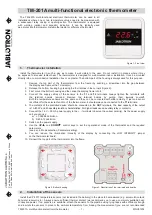
REV.1/25/05
Page 4 of 9 Part #17810
For REMOTE RECEIVERS that operate on BATTERY POWER, these heat conditions can cause batteries to discharge when
temperatures exceed 115
0
F. Studies show that alkaline batteries, when exposed to a constant temperature of 120
0
F
, can
lose up to 50% of their operating power. When the battery cools down, it will partially recharge itself, but constant heating and
cooling will reduce the battery’s normal life expectancy.
When the ambient temperature at the THERMISTOR,
inside the receiver case
, reaches 130
0
F
, the THERMISTOR will automatically
shut the appliance down and the RECEIVER will begin emitting a series of 2 “beeps”, every 4 seconds. When the ambient
temperature, at the RECEIVER, drops between 120
0
F
and 130
0
F
, the user can reactivate the appliance by pushing the MODE button
on the transmitter. The word ON must display on the LCD screen. When the ON button is pressed, the wall THERMISTOR “resets”
itself and the fireplace will begin operating again. However, the “beeping” will continue, if the ambient temperature remains between
120
0
F
and 130
0
F
. This “beeping” alerts the user that the RECEIVER should be repositioned so the ambient temperature drops below
120
0
F
.
When the temperature drops below 120
0
F
, the “beeping” will cease, providing the user has “reset” the THERMISTOR by
pushing the MODE button to ON to operate the appliance, either manually or thermally. Allow sufficient time for the receiver to
cool below 120
0
F
, and then press MODE button to stop beeping.
INSTALLATION INSTRUCTIONS
WARNING
This remote control system must be installed exactly as outlined in these instructions. Read all instructions completely before
attempting installation. Follow instructions carefully during installation. Any modifications of the ECS remote control or any of its
components will void the warranty and may be pose a fire hazard.
Do not connect any gas valve or electronic module directly to 110-120VAC power. Consult gas appliance manufacturer’s instructions
and wiring schematics for proper placement of all wires. All electronic modules are to be wired to manufacturer’s specifications.
The following wiring diagrams are for illustration purpose only. Follow instructions from manufacturer of gas valve and/or electronic
module for correct wiring procedures. Improper installation of electric components can cause damage to electronic module, gas valve
and remote receiver.
INSTALLATION
The remote receiver can be either wall-mounted in a standard plastic switch box or placed on or near the fireplace hearth. Preferably,
the remote receiver should be wall-mounted in a plastic switch box, as this will protect its electronic components from both the heat
produced by the gas appliance and potential damage or abuse that can occur if it is left exposed on the hearth. PROTECTION FROM
EXTREME HEAT IS VERY IMPORTANT. Like any piece of electronic equipment, the remote receiver should be kept away from
temperatures exceeding 130
0
F inside the receiver case. Battery life is also significantly shortened if batteries are exposed to high
temperatures.
Make sure the remote receiver switch is in the OFF position. It is recommended that 18 gauge stranded or solid wires (included) be
used to make connections between the terminal wiring block on the millivolt gas valve or electronic module and the wire terminals on
the remote receiver. For the best results, use 18 gauge stranded or solid wire, with no splices and measuring no longer than 20 ft.
WALL MOUNTING
Install 4 AA-size 1.5 ALKALINE batteries in the remote receiver. For best performance, remote receiver batteries should be factory
fresh when installed. Very little battery power is required to operate the remote receiver, but the electronics are tuned to operate best
when battery output is greater than 5.3 volts. Four new AA batteries should provide an output voltage of 6.0 to 6.2 volts.
Be sure
batteries are installed with the (+) and (-) ends facing the correct direction
.



























